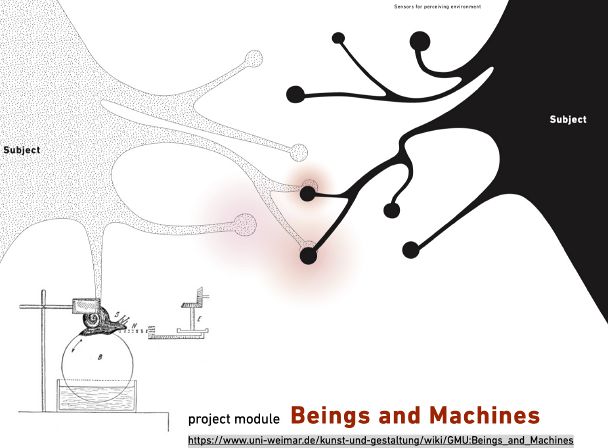Amy zimber (talk | contribs) m (→Materials) |
(nur ein link) |
||
| Line 67: | Line 67: | ||
*[https://www.informatik.uni-hamburg.de/TGI/forschung/projekte/sozionik/journal/2/psi2.pdf Synthetische Psychologie und Braitenberg] | *[https://www.informatik.uni-hamburg.de/TGI/forschung/projekte/sozionik/journal/2/psi2.pdf Synthetische Psychologie und Braitenberg] | ||
*[http://bioresearch.wdka.nl/wp-content/uploads/2020/05/GreenLight_TowardArtE_GeorgeGessert.pdf Green Light by George Gessert] | *[http://bioresearch.wdka.nl/wp-content/uploads/2020/05/GreenLight_TowardArtE_GeorgeGessert.pdf Green Light by George Gessert] | ||
*[https://danieljeffries.substack.com/p/its-time-to-fight-for-open-source fight for open source!] | |||
======Recommended Artists====== | ======Recommended Artists====== | ||
Revision as of 14:42, 27 November 2023
The project module introduces into media that moderate the living and the digital. We look into environments in their diverse natures, and how various actors live in them, network and relate to each other. The aim is to develop interfaces, methods and practices that enable such communication between different actors. The project addresses both questions of craftsmanship in the use of sensors as well as the performative use of media as an enactment of a writing of history and culture of technologies. In the end, our physicality is and remains the central point of orientation and the measure of reference and evaluation. Subjectivity - experienced as artistic expression - remains an essential measure for artefacts in the making. But addressing the subjectivity of the other person also means taking their interests into account and planning for them.
On this basis we want to thematize ideological questions that arise from the narratives of performance with media and how these can be brought into a non-violent relation and strategy to and in the present.
The project expects participants to conceive and elaborate a self-defined work, but also offers numerous literature and digressions on the topic.
Students are expected to be able and willing to work in a self-organized manner and to actively engage in the discourses of the module.
A prerequisite is prior enrollment in a specialized module with the co-workers of GMU or the Interface Design Professorship.
An accompanying course of the modules of the professorship is recommended.
Syllabus
each Monday we have lecture time at DBL at 15.15
- 10.10.2023: Informal meeting for coffee...
- 17.10.2023: First official meeting, introduction, Topics, lecture
- 24.10.2023: Your short presentations (recent works, plans for the semester)
- 31.10.2023: Holiday, no meeting
- 07.11.2023: You should present your concept and a workplan for the semester!
- 14.11.2023: Start with your lectures related to your topic
- 21.11.2023:
- 27.11.2023: 15.15 at DBL: Workshop with Daniel Wessolek
- 28.11.2023: Emil:; Amelia: Utopian methods of engaging; Steffen: on cognition
- 05.12.2023: Simon : Performing documents; Sabah; Amy:; Betül: enclosed environments
- 12.12.2023: Midterm Presentations
- 19.12.2023 Mojjo:
- 08.01.2024-11.01: class in Siegmundsburg: Excursion to Siegmundsburg and Jena with Dr. Klaus Fritze
- 16.01.2024: Cosmo: Water; Jan: Communication
- 23.01.2024: Lalicha: Art & Science, Mina:
- 30.01.2024:
- 06.02.2024: Final presentation
-> Moodle!
Hogger Interface Workshop [(27.11.2023) with Daniel Wessolek]
Sensors are great, but how do we collect their data? On the one hand, there is the classical data-logging approach of saving it all on e.g. a SD-card, on the other hand we can have on-the-fly data transmission over the Open Sound Control (OSC) protocol to a client. Regardless of which way you prefer, in this workshop we will be working on the interface design of a new open hardware project going by the name of Hogger. To hog things is normally not considered polite, but the Hogger is an data-logger, so it is o.k. in this case.
We will split in groups to think collectively about concrete scenarios, how you would use the Hogger, what the specific interface for your usage scenario should look like, where and how you would attach it, deal with the weather, battery limitations etc.
Does it need a display for you purpose? How do you adjust the settings, the interval, or maybe the IP port? With a rotary encoder? Buttons? We will find out together!
Drawing examples for concepts
- https://www.gansterer.org/
- https://www.adelheidmers.org/
- https://www.suzannetreister.net/
- https://www.tomasschmit.com/
- Carthographies of Time: A History of the Timeline ISBN 9781568987637
- Birgit Schneider, Christoph Ernst, Jan Wöpking: Diagrammatik-Reader; Grundlegende Texte aus Theorie und Geschichte ISBN 9783110380309
Materials
- W. Ross Ashby: Design for a Brain
- Stafford Beer: Designing Freedom
- Katherine Hayles on Cybernetics
- James Bridle: Ways of Being ISBN 9780141994260
- Peter Asaro: On the Origins of the Synthetic Mind: Working Models, Mechanisms, and Simulations german version
- Donna Haraway: Staying with the Trouble. Making Kin in the Chthulucene ISBN 978-0822362241
- Lynn Margulis: Symbiotic Planet: A New Look At Evolution ISBN 978-0465072729
- Inside Other Spaces. Environments by Women Artists 1956 – 1976
- Georg Trogemann, Code@Art first chapter
- The Architecture Machine
- Turtles by William Grey Walter
- Elvia Wilk This Compost
- Synthetische Psychologie und Braitenberg
- Green Light by George Gessert
- fight for open source!
Recommended Artists
- Adam Brown
- Verena Friedrich
- Agnes Meyer-Brandis [One Tree ID], [The Moon Goose Analogue] and others...
- Tomomi Adachi
- Niklas Roy [Windmills]
- Felipe Castelblanco [Video Reporte por Ñambi Rimai Colectivo de Medios: Quemas de Páramo en el Pueblo Quillacinga], [La Jungla Amazónica]
- Ursula Biemann
- Lygia Clark
- Jenna Sutela
- Hyungkoo Lee
- Robertina Sebjanic [Aurelia 1-Hz]
- Neozoon, [My BBY 8L3W ]
- William Forsythe [https://synchronousobjects.osu.edu/]
- Thomas Drehers Website on Computer Art
- Tabita Rezaire
